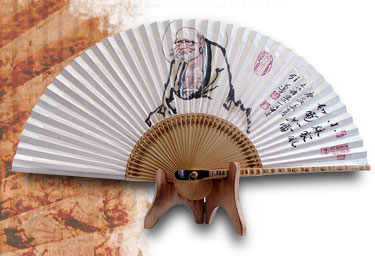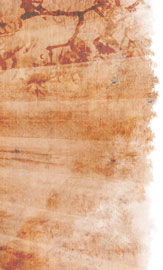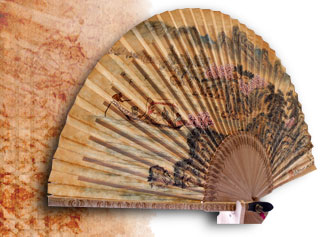 It is an unchanging truth among fan makers that no fan can create a cool breeze unless It is an unchanging truth among fan makers that no fan can create a cool breeze unless
 it is soaked with the maker’s sweat. It usually takes 100 days to make a hand held fan
it is soaked with the maker’s sweat. It usually takes 100 days to make a hand held fan
 piece, starting with the stage of cutting the quality bamboo, followed by each phase
piece, starting with the stage of cutting the quality bamboo, followed by each phase
 made by the artisan’s hands. Naturally, the hands of Seonjajang Yi Gi-dong, who
made by the artisan’s hands. Naturally, the hands of Seonjajang Yi Gi-dong, who
 has been living with fans all his life, are covered with wounds and cuts by the
has been living with fans all his life, are covered with wounds and cuts by the
 sharp bamboo strips. Because hand fan making is complicated, the
sharp bamboo strips. Because hand fan making is complicated, the
 Joseon administration operated six specialized workshops under a head
Joseon administration operated six specialized workshops under a head
 establishment named Seonjabang, or Office of Fans. They were:
establishment named Seonjabang, or Office of Fans. They were:
 Golseonbang ('Fan Structure Workshop'), where bamboo was cut into thin
Golseonbang ('Fan Structure Workshop'), where bamboo was cut into thin
 strips; Nakjukbang ('Pyrography Workshop') where fan ribs were decorated
strips; Nakjukbang ('Pyrography Workshop') where fan ribs were decorated
 with nakjuk designs; Gwangbang ('Polish Workshop') where the ribs were
with nakjuk designs; Gwangbang ('Polish Workshop') where the ribs were
 polished after the nakjuk decoration; Sabokbang ('Sand-Fortune Workshop') where all
polished after the nakjuk decoration; Sabokbang ('Sand-Fortune Workshop') where all
 the fan’s bamboo ribs were riveted; Dobaebang ('Papering Workshop') where the ribs were
the fan’s bamboo ribs were riveted; Dobaebang ('Papering Workshop') where the ribs were
 covered with mulberry paper; and Grimbang ('Painting Workshop'), where the paper was painted
covered with mulberry paper; and Grimbang ('Painting Workshop'), where the paper was painted
 or calligraphy was drawn upon it. or calligraphy was drawn upon it.
The main material of Korean hand fan, bamboo that has grown for three to four years without any flaw on its skin, is
prepared by harvesting it during the winter. The two edge ribs of a fan should be made by using thicker bamboo strips
with close joints. For Yi, bamboo from Geojedo Island is the best for such purposes and he makes annual visits to
the island to find the right bamboo. After it has been reaped and cut into the proper sizes, the bamboo needs to be
soaked in caustic soda to rid it of resin, then needs to dry for about 20 days in direct sunlight so it becomes bleached.
Afterwards, the bamboo is soaked in water for about a week before boiling. After this treatment, the bamboo displays
an attractive natural color without the greenish touches it originally had. What follows is the most difficult part of all in
fan making: producing pliable paper-thin strips out of the bamboo. If a strip is too thick, the fan can become too chunky,
whereas strips that are too thin can easily be broken when the fan is being used. Only ribs with the right thickness
can produce a fine hapjukseon that displays the figure of a beautiful woman, held in the user’s hand in an attractively
comfortable way.
 A fine hapjukseon fits beautifully in the hand and the flexibility of the bamboo ribs creates a A fine hapjukseon fits beautifully in the hand and the flexibility of the bamboo ribs creates a
 wonderfully pleasant breeze, neither too strong nor too weak. In fact, the secret is hidden in the
wonderfully pleasant breeze, neither too strong nor too weak. In fact, the secret is hidden in the
 glue used to apply the mulberry paper onto the bamboo ribs. Made from the air bladder of a
glue used to apply the mulberry paper onto the bamboo ribs. Made from the air bladder of a
 type of fish called a croaker, this unique fish glue is the same adhesive used for many
type of fish called a croaker, this unique fish glue is the same adhesive used for many
 traditional craftworks of Korea, including mother-of-pearl objects, furniture and bows and
traditional craftworks of Korea, including mother-of-pearl objects, furniture and bows and
 arrows. Only when this fish glue is used, a hapsukseon can attain the optimum pliability
arrows. Only when this fish glue is used, a hapsukseon can attain the optimum pliability
 and strength that it needs.
and strength that it needs.
 Another element to add attraction and beauty to a Korean paper fan is the use of hwangchil Another element to add attraction and beauty to a Korean paper fan is the use of hwangchil
 ('yellow lacquer'), a natural lacquer applied to paper before it has been painted or has
('yellow lacquer'), a natural lacquer applied to paper before it has been painted or has
 had calligraphy composed on it. Taken from a Korean native lacquer tree grown in and
had calligraphy composed on it. Taken from a Korean native lacquer tree grown in and
 around the islands and coastal areas south of the Korean peninsula, this golden
around the islands and coastal areas south of the Korean peninsula, this golden
 translucent pigment creates mysteriously elegant colors. For its attractive rare golden hue,
translucent pigment creates mysteriously elegant colors. For its attractive rare golden hue,
 the pigment has been an important export item since the Three Kingdoms Period
the pigment has been an important export item since the Three Kingdoms Period
 (57 B.C.-668 A.D.). Not only the color, but also the sweet natural fragrance emanating from it
(57 B.C.-668 A.D.). Not only the color, but also the sweet natural fragrance emanating from it
 adds delightful joy to the users of hapjukseon.
adds delightful joy to the users of hapjukseon.
These works of art made of bamboo and Korean mulberry paper by the great artisan, Seonjajang Yi, emit a cool breeze
containing the breath of ancient tradition and mysterious nature that envelops contemporary people, who depend on the
unnatural electricity-made cold wind to expel the mid-summer heat, reminding them of the simplicity and beauty of the
natural world.
View the master's works
|


















